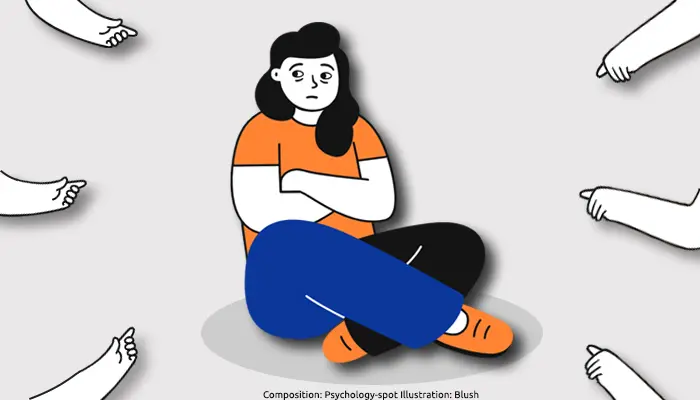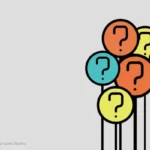
In the recrimination game, blame turns into poison darts that, sooner rather than later, will target us. If we accept the blame of others and set out to shoulder responsibilities that are not ours, we run the risk of becoming someone’s scapegoat. And once we have assumed that role, it is very difficult to get rid of the enormous emotional weight that it carries.
What does “scapegoat” mean? History, symbolism and bad luck
To celebrate the Day of Atonement, a journey involving confession of sins and repentance throughout the year, the ancient Jews chose two goats. Then they randomly selected one of the animals to sacrifice to Yahveh.
“He is to cast lots for the two goats—one lot for the Lord and the other for the scapegoat”, reads Leviticus 16 in the Old Testament. “Aaron shall bring the goat whose lot falls to the Lord and sacrifice it for a sin offering.”
The other goat did not run with better luck since the guilt of all sins fell on him. The rabbi placed his hands on the animal’s head in a symbolic ceremony to transfer the people’s guilt to the animal.
Later the goat was taken to the desert as an emissary, where they abandoned him. Although it is also said that they stoned him to death since by that sacrifice the people could clean and erase their sins.
From that tradition came the expression “scapegoat.” On a psychological level, this phenomenon continues to maintain its main historical characteristic: the scapegoat is chosen at random to carry guilt that does not correspond to it and thus release – in the real or metaphorical sense – whoever has the true responsibility.
What is a scapegoat in psychology?
In Psychology, the scapegoat is the person or group that we want to blame, even though they are innocent, to exonerate the real culprit. Therefore, it is a person on whom fall the accusations or convictions, although he is not the true person responsible for what happened.
History is full of scapegoats since this phenomenon is as old as man himself. Perhaps one of the most tragic and iconic examples of the scapegoat was the process of blame that the Nazis launched against the Jews, just because they seemed to be more successful in their businesses while many other Germans were suffering the devastating consequences of the First World War.
Today, different groups carry the stigma that comes with being considered a scapegoat. Such is the case of immigrants or social minorities on which a part of the society discharges their discomfort. Many political leaders, especially in times of crisis, also unscrupulously exploit the scapegoat mechanism to divert attention from their own shortcomings and attempt to evade their legitimate burden of responsibility by placing it on other actors.
This process of blaming is also common in dysfunctional families, in which groupal psychological difficulties and complexes are transferred to a specific member. That person is the one who bears all the problems, shame and guilt of the family, thus diverting attention from the real conflicts that must be resolved.
Why do we need a scapegoat?
The phenomenon of the scapegoat in Psychology can be traced to two Freudian defense mechanisms: displacement and projection. In fact, the choice of the scapegoat is often an unconsciously fueled process.
According to Freud, to maintain a certain balance, both psychologically and interpsychologically, we have the tendency to remove from our consciousness the things, emotions, impulses or thoughts that bother us or that represent a conflict.
When something breeds hostility, we tend to shift that feeling toward more socially acceptable goals or more vulnerable people who are not a danger to us. For example, instead of getting angry at our boss we can end up displacing that anger towards the partner, in which case it will become our scapegoat.
In other cases, the scapegoat is the result of a projection; that is, to project those feelings or anxieties that we do not accept in ourselves on others. The problem is that accepting these feelings would alter the image we have of ourselves, would provoke a cognitive dissonance, so that by projecting them onto others we maintain a tension-free relationship with our “self”. So, for example, we can blame our partner for not listening to us, when in fact we are not listening.
When we feel frustrated because we see no way to solve the problem and it becomes too threatening, the simplest response to channel that helplessness, fear, or anxiety is to direct it to a third person or group.
Thus, creating a scapegoat responds to two psychological reasons: 1. Maintaining perceived personal moral worth by minimizing feelings of guilt about responsibility for a negative outcome, and 2. Maintaining perceived personal control by obtaining a clear explanation of a negative result that otherwise seems inexplicable, as explained psychologists from the University of Southern Mississippi.
When we find someone to blame for misfortune, problems, social calamities, or even pandemics, we ease our own responsibilities and dispel unacceptable shadows. We also strengthen our misrepresented sense of power and justice, while alleviating guilt and shame, ridding ourselves of the need to do something as the responsibility is not ours.
The scapegoat therefore becomes a kind of punching bag, the reservoir where we leave the most painful or complicated problems and conflicts to resolve. Thus we do not have to delve too deeply into its causes. We simplify everything. And we alleviate the psychological pain that would come with accepting certain blames and responsibilities.
The problem is that creating a scapegoat doesn’t solve the problems. Closing our eyes to our shadows will not make them disappear. Blaming the other does not resolve our conflicts and creates new problems for the person who is carrying responsibilities that do not correspond to him.
The emotional wounds of the scapegoat
Many people who have become scapegoats are not fully aware of this dynamic. Given that those who blame are usually people with whom we have a close emotional bond or people who occupy positions of power, the most common thing is that we take on these faults. We do not realize that we are involved in a situation of psychological abuse until it is too late and the damage is already done.
Scapegoats often experience great suffering and anguish since they have been through years of invalidation and abuse. Parents who have blamed them for ruining their lives, highly toxic partners or bosses who do not assume their responsibilities.
Those people are weaving a story based on lies, denial and distortion of reality in which the scapegoat becomes the only culprit for all the misfortunes that occur. As a result, it is not uncommon for that person to end up believing that they are mean or worthless.
That person will find it increasingly difficult to identify his wants and needs, believe that he is not worthy of being successful or loved, and will lose confidence in his abilities to pursue his goals and dreams. He is also likely to blame himself excessively and feel he has no right to be happy.
To get out of these networks, we have to break with the stereotypes of the villain/culprit and the hero/victim. That means assuming that there is no one completely good or completely evil. And that in any relationship, responsibilities or blame are distributed.
It is never too late to discover and reclaim our true identity, free from the distorted and blaming narrative that others want to impose and that paint us as “bad” or “wrong”.
Sources:
Rothschild, Z. K. et. Al. (2012) A Dual-Motive Model of Scapegoating: Displacing Blame to Reduce Guilt or Increase Control. J Pers Soc Psychol; 102(6): 1148-1163.
Glick, P. (2002) Sacrificial lambs dressed in wolves’ clothing: Envious prejudice, ideology, and the scapegoating of Jews. In L. S. Newman & R. Erber (Eds.) Understanding genocide: The social psychology of the Holocaust (pp. 113-142). New York: Oxford University Press.
Wright, F. et. Al. (1988) Perspectives on scapegoating in primary groups. Eastern Group Psychotherapy Society; 12(1): 33-44.
Eagle, J., & Newton, P. M. (1981) Scapegoating in small groups: An organizational approach. Human Relations; 34(4): 283–301.



